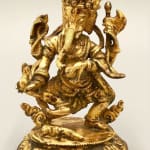Gilt-Bronze Figure of Ganapati (Ganesha), 13th Century CE - 17th Century CE
3.4 x 6 x 2.5
cb.2892
Further images
This is a gilt-bronze standing sculpture of Ganapati (Ganesha). Coherent with his iconography, the four-armed and elephant-Headed Hindu-Buddhist deity holds his own broken tusk in his lower-right hand and holds...
This is a gilt-bronze standing sculpture of Ganapati (Ganesha). Coherent with his iconography, the four-armed and elephant-Headed Hindu-Buddhist deity holds his own broken tusk in his lower-right hand and holds a delicacy, which he samples with his trunk, in his lower-left hand. The two upper hands hold an axe and a noose respectively. The base seal shows traces of restoration or possibly a replacement seal. The figure reflects several typical features of Pala and Nepalese style; the standing or prancing form of the figure, the single lotus base, and the deliberate inclusion of tantric decorative elements. This is due to the extensive artistic exchange with neighbouring regions, as well as their close diplomatic ties with Hindu-Buddhist Javanese states.
Ganesh, a much-beloved and worshiped deity, is the son of Lord Shiva and Parvati. He is also known as the God of wisdom, prosperity and auspiciousness. Ganesh can be depicted in many postures and forms, typically with four or eight arms, holding various symbolic objects. Lord Ganesh is often displayed dancing or playing a musical instrument, such as a flute. He is sometimes accompanied by or riding a rat (or the mouse) – a symbol of all-pervasiveness. The rat can be interpreted as under Ganesh’s control, which is symbolic of a spiritual pursuit to attain self-realization and grace. Even the position of Lord Ganesh’s trunk has significance and special meaning. Like all of Ganesh’s symbols and traits, each hold an interesting difference in the benefits devotees would get. If the idol trunk turns left, it signifies blessings of wealth, success and pleasure. To his right, the trunk represents moksha-related benefits – understanding that all pleasures on earth are momentary and to take the path of achieving bliss. The most iconic legend of Ganesh, however, is perhaps the story how his tusk was broken. It is said that Ganesh once battled with Parashurama (Axe-wielding Rama), an avatar of Lord Vishnu. Since the axe of Parashurama is a gift from Shiva, Ganesh’s father, Ganesh decided not to dodge the attack to honour his father’s name and got his tusk cut off in the process. Historically significant and artistically advanced, this figure of Ganesh is a testament of beauty and craftsmanship, which embodies the transition and convergence of Hinduism and Buddhism in the Himalayan region centuries ago.
-Danny Ching
Ganesh, a much-beloved and worshiped deity, is the son of Lord Shiva and Parvati. He is also known as the God of wisdom, prosperity and auspiciousness. Ganesh can be depicted in many postures and forms, typically with four or eight arms, holding various symbolic objects. Lord Ganesh is often displayed dancing or playing a musical instrument, such as a flute. He is sometimes accompanied by or riding a rat (or the mouse) – a symbol of all-pervasiveness. The rat can be interpreted as under Ganesh’s control, which is symbolic of a spiritual pursuit to attain self-realization and grace. Even the position of Lord Ganesh’s trunk has significance and special meaning. Like all of Ganesh’s symbols and traits, each hold an interesting difference in the benefits devotees would get. If the idol trunk turns left, it signifies blessings of wealth, success and pleasure. To his right, the trunk represents moksha-related benefits – understanding that all pleasures on earth are momentary and to take the path of achieving bliss. The most iconic legend of Ganesh, however, is perhaps the story how his tusk was broken. It is said that Ganesh once battled with Parashurama (Axe-wielding Rama), an avatar of Lord Vishnu. Since the axe of Parashurama is a gift from Shiva, Ganesh’s father, Ganesh decided not to dodge the attack to honour his father’s name and got his tusk cut off in the process. Historically significant and artistically advanced, this figure of Ganesh is a testament of beauty and craftsmanship, which embodies the transition and convergence of Hinduism and Buddhism in the Himalayan region centuries ago.
-Danny Ching





